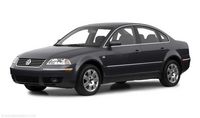New Car/Review
Volkswagen New Passat GLX (2001.5)
SEE ALSO: Volkswagen Buyer's Guide
by John Heilig
SPECIFICATIONS MODEL: 2001.5 Volkswagen New Passat GLX ENGINE: 2.8-liter 90 degree V6 HORSEPOWER/TORQUE: 190 hp @ 6000 rpm/206 lb-ft @ 3200 rpm TRANSMISSION: Five-speed automatic WHEELBASE: 106.4 in. LENGTH x WIDTH x HEIGHT: 185.2 x 68.7 x 57.6 in. STICKER PRICE: $21,750 (base for GLS)
Volkswagen introduced the car that they are now marketing as the mid-size Passat in the 1960s as the Dasher. It evolved through the Dasher and became the Passat in 1989. Despite all the name changes, the car remains a solid mid-size sedan with a lot to offer.
As with all manufacturers who sell a product, the next generation is in development. The Passat, for example, was in the process of being "enhanced" with more than 2300 changes to make it a better vehicle. VW hoped to introduce the New Passat as a 2001 model later this year, but the supply of "old Passats" was dwindling and an executive decision had to be made. The decision was to introduce the New Passat (note the connection with the New Beetle) as a 2001.5 model so as not to confuse people who had bought model year 2001 new Old Passats (does all that make sense to you?).
We had an opportunity to drive the New Passat at the vehicle's press introduction and came away favorably impressed with its build quality, performance and solidity. The new Passat reflects subtle design changes that make it more aerodynamic without changing the basic character of the car. Only the roof and doors remain unchanged form its predecessor. Interior dimensions remain identical to the Old Passat, while exterior dimensions are changed only by the more aerodynamic front end.
That front end is accentuated by the headlight treatment, which includes halogen headlamps and clear lens side blinkers. There is a new larger grille with a distinctly larger "VW" crest in the center. The grille is more sharply raked and there is a seamless transition from front bumper to grille. One brand feature that VW is trying to incorporate into all its vehicles is a minimum of seams between body sections. When there are seams, the company is trying to improve fit and finish so the seams are as tight as possible.
VW has also restyled the rear of the car. There's a resemblance to the Chevy Monte Carlo in the taillight treatment, which isn't bad. Fully transparent rear lamps each encompass two small round lenses for the brake light and rear light, as well as turn signals.
Inside, there's a new console with size-adjustable cupholders that will accommodate almost any size cup. The center console also includes a larger compartmentalized storage area. The steering wheel is multifunctional and includes sound system and cruise control switches.
More importantly, Volkswagen has engineered more torsional rigidity, making the New Passat more solid. Torsional rigidity translates as flex resistance and gives the New Passat a solid feel that is more in line with much larger vehicles. This rigidity has been achieved with added structural members and new laser welding techniques.
With a more rigid chassis, it is possible to create a better balance between sports-car-like responsiveness and driving comfort. We took the New Passat over some interesting winding roads and the car tracked well and maintained a flat attitude through all the corners. But unlike some sports car, the car also gave us a comfortable ride on Interstates and other straight roads. We also had a stretch of city driving included in our course and felt comfortable duking it out with the other cars on the road.
Under the hood of both the vehicles we tested was a 2.8-liter 90-degree V6 engine that delivered 190 horsepower and 206 lbs. ft. of torque. This engine was super. It was quiet, which is always important in a sedan that will carry people who may actually want to talk. And it had power, which is important if you want to accelerate away from stop signs or keep up with the other traffic on the highway. Not only did we keep up with the other traffic, we were usually passing it. I had to use the cruise control to keep the car within legal speed limits or the introduction trip could have proven to be expensive. Interestingly, one of our test legs brought us past the racing garage of "Awesome Bill from Dawsonville" (you figure out who that is), and we felt his crew might want to look at our car.
We also drove a station wagon version of the New Passat that was equipped with 4Motion, VW's all-wheel drive system. While the wagon didn't appear to have the same performance as the sedan, the package was a good one. I view wagons as more family oriented than sedans, so performance is not part of the buying equation for me. It may be for you.
Overall, the New Passat is a solid vehicle with excellent performance. It continues VW's tradition of offering solid vehicles that are right for the market. VW said it expects to sell 25,000 or so New Passats, yet this is a vehicle that could easily compete with the Japanese mid-size cars, such as Camry and Accord with no effort. I think they're aiming too low.



